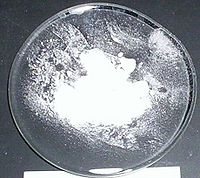Barium chloride
| Barium chloride | |
|---|---|
 |
|
| Identifiers | |
| CAS number | 10361-37-2 10326-27-9 (dihydrate) |
| EC number | 233-788-1 |
| RTECS number | CQ8750000 (anhydrous) CQ8751000 (dihydrate) |
| Properties | |
| Molecular formula | BaCl2 |
| Molar mass | 208.23 g/mol (anhydrous) 244.26 g/mol (dihydrate) |
| Appearance | White solid |
| Density | 3.856 g/cm3 (anhydrous) 3.0979 g/cm3 (dihydrate) |
| Melting point |
962 °C |
| Boiling point |
1560 °C |
| Solubility in water | 31.2 g/100 mL (0 °C) 35.8 g/100 mL (20 °C) 59.4 g/100 mL (100 °C) |
| Solubility | soluble in methanol, insoluble in ethanol, ethyl acetate [1] |
| Structure | |
| Crystal structure | orthogonal (anhydrous) monoclinic (dihydrate) |
| Coordination geometry |
7-9 |
| Thermochemistry | |
| Std enthalpy of formation ΔfH |
−858.56 kJ/mol |
| Hazards | |
| EU Index | 056-004-00-8 |
| EU classification | Toxic (T) Harmful (Xn) |
| R-phrases | R20, R25 |
| S-phrases | (S1/2), S45 |
| NFPA 704 |
 0
2
0
|
| Flash point | Non-flammable |
| Related compounds | |
| Other anions | Barium fluoride Barium bromide Barium iodide |
| Other cations | Calcium chloride Strontium chloride Lead chloride |
| Except where noted otherwise, data are given for materials in their standard state (at 25 °C, 100 kPa) |
|
| Infobox references | |
Barium chloride is the ionic chemical compound with the formula BaCl2. It is one of the most important water-soluble salts of barium. Like other barium salts, it is toxic and imparts a yellow-green coloration to a flame. It is also hygroscopic.
Contents |
Structure and properties
BaCl2 crystallizes in both the fluorite and lead chloride motifs, both of which accommodate the preference of the large Ba2+ ion for coordination numbers greater than six.[2] In aqueous solution BaCl2 behaves as a simple salt; in water it is a 1:2 electrolyte and the solution exhibits a neutral pH.
Barium chloride reacts with sulfate ion to produce a thick white precipitate of barium sulfate.
- Ba2+(aq) + SO42-(aq) → BaSO4(s)
Oxalate effects a similar reaction:
- Ba2+(aq) + C2O42-(aq) → BaC2O4(s)
Preparation
Although inexpensively available, barium chloride can be prepared from barium hydroxide or barium carbonate, with barium carbonate being found naturally as the mineral witherite. These basic salts react with hydrochloric acid to give hydrated barium chloride. On an industrial scale, it is prepared via a two step process from barite (barium sulfate):[3]
This first step requires high temperatures.
- BaS + CaCl2 → BaCl2 + CaS
The second step requires fusion of the reactants. The BaCl2 can then be leached out from the mixture with water.
From water solutions of barium chloride, the dihydrate can be crystallized as white crystals: BaCl2·2H2O
Uses
As a cheap, soluble salt of barium, barium chloride finds wide application in the laboratory. It is commonly used as a test for sulfate ion (see chemical properties above). In industry, barium chloride is mainly used in the purification of brine solution in caustic chlorine plants and also in the manufacture of heat treatment salts, case hardening of steel, in the manufacture of pigments, and in the manufacture of other barium salts. BaCl2 is also used in fireworks to give a bright green color. However, its toxicity limits its applicability. Barium Chloride is also used (with Hydrochloric acid) as a test for sulfates. When these two chemicals are mixed with a sulfate salt, a white precipitate forms, which is barium sulfate.
Safety
Barium chloride, along with other water-soluble barium salts, is highly toxic. Sodium and magnesium sulfate are potential antidotes because they form the insoluble solid barium sulfate BaSO4, which is much less toxic.
References
- ↑ Pradyot Patnaik. Handbook of Inorganic Chemicals. McGraw-Hill, 2002, ISBN 0070494398
- ↑ Wells, A.F. (1984) Structural Inorganic Chemistry, Oxford: Clarendon Press. ISBN 0-19-855370-6.
- ↑ H. Nechamkin, The Chemistry of the Element, McGraw-Hill, New York, 1968.
- Greenwood, N. N.; & Earnshaw, A. (1997). Chemistry of the Elements (2nd Edn.), Oxford: Butterworth-Heinemann. ISBN 0-7506-3365-4.
- Handbook of Chemistry and Physics, 71st edition, CRC Press, Ann Arbor, Michigan, 1990.
- The Merck Index, 7th edition, Merck & Co., Rahway, New Jersey, 1960.
External links
- International Chemical Safety Card 0614. (anhydrous)
- International Chemical Safety Card 0615. (dihydrate)
- NIOSH Pocket Guide to Chemical Hazards.
- European Chemicals Bureau.
- Barium chloride's use in industry.
|
|||||